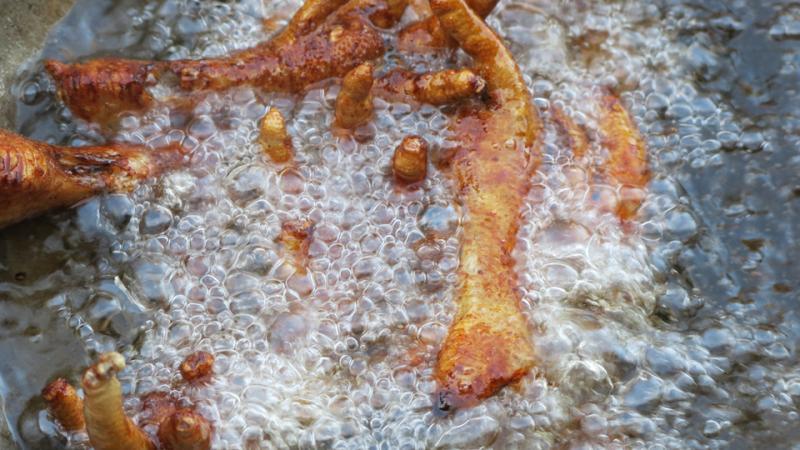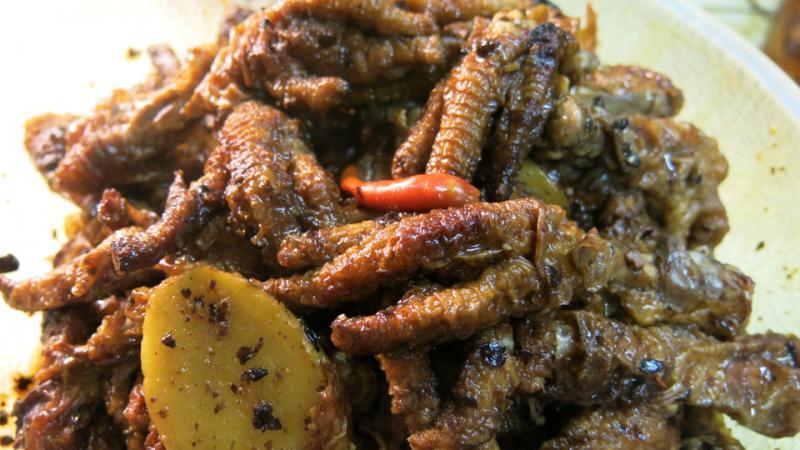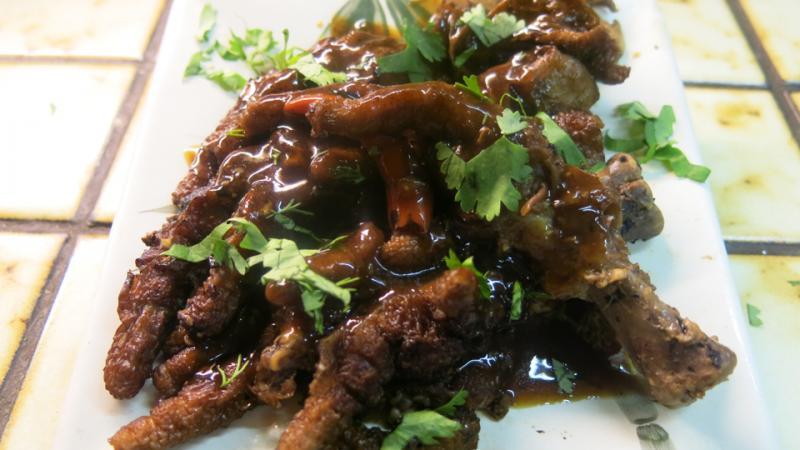Search the Community
Showing results for 'wok'.
Found 5,149 results
-
I've decided to buy a new wok. I'm going to buy a carbon steel wok but I'm a little unsure about the diameter. The one I've currently got is 12 inches in diameter. I'll be using it on a home gas cooker. I think that 12 inches diameter is a little small. Are there people on here with any views regarding size? I was thinking of 13 and possibly even 14 inches in diameter wiht a flat bottom. Thanks. Edited to add that I've been looking at this: http://www.ebay.co.uk/itm/Carbon-Steel-Wok-33-cm-13-inches-Flat-or-Round-Bottom-in-variation-listing-/131009038650?pt=UK_HomeGarden_Kitchen_Cookware_GL&var=&hash=item1e80bf493a
-
I regularly do Chinese style stuffed mushrooms, which are fried and steamed rather than baked. They are fresh shiitake mushrooms stuffed with a pork mince seasoned with he usual Chines suspects - ginger, garlic, spring onion, chilli, salt. Fry stuffing side down till browned, flip and fry the other side for about the same length of time. Add a little water/stock to the pan/wok, cover and steam for 4 to 5 minutes. Most of the liquid should have evaporated. What remains can be splashed over the mushrooms before serving. Alternatively, I just steam them on top of the rice in the rice cooker, without the initial frying. When the rice is ready, so are they.
-
I haven't made these for a long time, but a friend just gave me 10 lbs of cleaned plump chicken feet. Cantonese dim sum style Golden Phoenix Palms is not easy to come by in our small city. I love these and decided I needed to make a pile and have ready in the freezer for a treat anytime! The set up for deep frying outside. Once brown and crispy, the feet were tossed into a pot of ice water. Sizzling in the wok of hot oil. I had the flame on high. There was a lot of splattering, but I didn't care - nothing to clean up in the house and I stayed far away after I first put them in: The feet were simmered for 1.5 hours The simmered feet were drained, cooled then coated with a marinade to sit overnight. Steamed for 15 minutes and ready to enjoy!
-
as i mentioned in my earlier post on this thread to the OP, it depends on how you use or will use the wok. If you use the wok as in 'Woking 9 to 5. :-)' then probably you would have gone thru various cooking techniques on that one wok, including steaming, stir fry, shallow fry deep fry, braising,etc, just like in the olden days in China when the wok was the only or main cooking utensil. Once you do stir fry, shallow fry, deep frying, you are re-seasoning the wok. Try this experiment, use your wok to steam something 2 or 3 times, and then braise something acidic on it for 2 to 3 hours and see what you have as seasoning on your wok No I am not. I use the wok for frying eggs for breakfast, make lunch and dinner, hence 9 to 5. A chef would be 8 to 11 p.m. :-) dcarch
-
No I am not. I use the wok for frying eggs for breakfast, make lunch and dinner, hence 9 to 5. A chef would be 8 to 11 p.m. :-) dcarch
-
this was what i was told when i wanted to develop my wok skills, a long time ago., Use uncooked rice, because it is cheap, and if you are worried about waste, you can buy broken rice, and then after your practice put it into a net to feed the birds, or cook it for your cat or dog if you have one. with uncooked rice, you can if you want look at each of the grains and see how they have been cooked, are they burnt on one side and still raw on the other? then you still have a way to go. with sand or salt, you have no way to tell how they have been cooked.
-
Because I've found very high heat to evaporate the seasoning right off the wok - if not entirely, then partially. This is the same on my cast iron pan, and I went through the whole flaxseed oil 6-times-in-the-oven seasoning process with that.
-
I'm using uncooked rice in order to practice the stir-frying movement of flipping the contents back. This guy in China told me to practice with some salt in the wok. Another with some sand. Are you a Chinese Chef dcarch?
-
Woking 9 to 5. :-) for me. Why are you using a wok for uncooked rice? What are you making? dcarch
-
Have any of you practiced using a wok? I'm doing it with some un-cooked rice at the moment. Any advice?
-
The incredible geometry of a wok was "invented" by accident long time ago, I think. If you take a sheet of steel and keep hammering it, you will end up with a wok. Not much skill is required. That's what I saw how woks were made in villages when I was in China long time ago. You can't make a skillet, or a frying pan with just a hammer. Yes, you can do some of the things with a flat bottom wok, but there is no substitute for some of the functionality of a round bottom wok. I fail to understand all the talk about how careful you need to be to protect the seasoned surface of a wok. I wash, scrub, burn, boil, steam ----- with my wok, the seasoning just keeps on building up better and better. dcarch
-
No one said, round bottom woks aren't available. The point was that flat bottomed woks are much more common, now and that flat bottomed ones are less easy top find.. For the reasons already given. I notice that you searched for 'round-bottom woks'. That is likely to screw the results somewhat. Why not just search for 'woks' if you really want to know what is available? Anyway, some of the results clearly show flat-bottomed woks. Taobao's search engine is not very good, at all. Very. The weight of the wok (and its contents) keeps them stable. I don't know what kind of boisterous dining you go in for but, in any Chinese home I've ever been in, the hotpot is set safely in the centre of the table, and the guests tend not to go in for table top dancing, so there is no danger of anyone kicking it over. Which is exactly what people do - both in restaurants and at home. Several of my friends have dedicated kettles for holding topping-up hotpot stock. Restaurants also frequently use kettles. Some places, including one I visit regularly, has dedicated hotpot stock topper-up girls who patrol the restaurant with their kettles.
-
If you are still considering what type of wok to buy you may want to consider what you want to do with the wok, ie what are you going to cook in it, how often, and your skill level in wok cooking. Bottom line, a wok is cheap enough that if you are not satisfied with the wok that you bought, it would not be a big deal to try another. It is not the same as deciding on buying a set of All Clad, or its competition. In days gone by, the wok was the only cooking utensil, but i doubt if that is what you want. I would not use it as a steamer or do long acidic braises in it, as that will undo all the effort you would have made to season it, unless you want to re season it after each use. A regular chinese steamer is cheap enough that the only reason not to buy one is if you do not have the storage space for it, or if you do not steam cook. hzrt8w, who used to be a prolific poster, uses a regular skillet or fry pan, and if i remember correctly on an electric ring stove. What i find interesting is that with minimal equipment, he could, with his skills, turn out fantastic Cantonese cuisine, or looks fantastic as i never had a chance to taste any of it. With Cantonese stir fry there seems to be an obsession with mega BTUs. Of course a megaBTU heat source is important.... in a restaurant environment, or if you have the means to set it up in your home. Otherwise, i always say that you can get satisfactory wok hei even on the most anemic cook top, if, for example, you cook single portions or servings separately, and also add in each ingredient separately and not dump in all ingredients all at once; and some would say its a PITA if you are cooking for 4 or more. And i would not use a wok as the pot in hotpot cooking. If you have a wok that is 12 or 14 inches in diameter balanced on a flat bottom of 6 inches, how stable would that configuration be? Especially in a boisterous environment, as most of my hotpot dinners are. The rate of evaporation in a wok will be such that you will have to prepare lots of stock in advance and be replenishing it frequently as it evaporates and condenses on the walls, etc. And how much do those dedicated pots for hotpots cost anyways? With or without the central divider? And if you want a multi-use pot, why not buy a fondue pot and then you can have all the cheese fondues, fondue bourguignonne, chinese hotpot, etc. And if you want to know what kinds of woks are easily available in China, check out this search on taobao http://tinyurl.com/q2h8wsj , round bottoms are alive and well in China.
-
My son is home for a couple of days. Promised him Mexican tonight and Prime Rib tomorrow night. I have this huge cast iron round griddle given to me by a neighbour a few years ago that I had never used. But I used it twice in the last week to make a couple of stir fry type dishes - one with pork the other with beef tenderloin. I don't think I will use my wok again. It was perfect for tonight's Chicken Fajitas. Marinated the chicken in a little of the homemade salsa. On the griddle. Lots of room - no crowding. 23" in diameter. Moved the chicken off to the side. Added the onions and green peppers. Served off the griddle with homemade flour tortillas. With salsa and Guacamole. Matthew made the Guacamole.
- 572 replies
-
- 12
-

-
I have woks and numerous cast iron Dutch ovens and chicken fryers, they work okay. What i'm interested in is something perfect for small batch deep frying that's relatively deep and narrow so it requires little oil, yet heavy enough to maintain temperature well.
-
Try a wok. 1. The large diameter of a wok minimizes splatter. 2. The round bottom allows large or small amount of frying. 3. The rack that sits on the wok allows draining of oil after frying. It works better than draining on paper towel because hot oil is more fluid. dcarch
-
The rice is cooked. A pressure cooker would explode the grains. Bain-Marie... (why am I doing this ?) WOK IT. A small amount of oil in the WOK, toss in the cold rice. Turn it and turn again, when 'HOT', : Sprinkle with seame oil, then soya sauce. You then have something that your mother should have told you about..
-

San Francisco digging deep gourmet shopping
gfron1 replied to a topic in California: Cooking & Baking
I did hit the wokshop and loved it. Grabbed a specialty wok, but also picked up some new mooncake molds and got a lesson in using them. -
for me, that one super gadget is a French chef's knife. cost less than $20 at Bed, Bath & Beyond. for others, could be a cleaver and a wok. you can use a wok for all sorts of things, not just Asian food. steaming, for example, or smoking meat or fish, or making scrambled eggs. what is necessary isn't always expensive.
-
OK, here's a listing off the top of my head of stuff that straddles breakfast-lunch and beyond...hopefully the OP might allow that "noodle dishes just for breakfast" may not be entirely found in practice. ------------------ Note: Many of those below tend to straddle the mid/late-morning through lunch into late-afternoon periods, although they can also be had fairly early in the morning in some places. Some (like “Char Kway Teow”, wonton meen, some forms of “kari mee”, etc) are found in the early a.m. more commonly than some others. It depends on the locality. There is also no requirement that these things be eaten ONLY for breakfast or ONLY for lunch, as has been pointed out already; they are eaten whenever, although perhaps less commonly for dinner. The "Curry Laksa" you cite, for example, is eaten throughout the day, as has also been mentioned. Kari Mee of some sort is also frequently found for dinner in various places - here's just one example. (I commonly ate chee cheong fun (w/ or w/o some YTF) or mee goreng or char kway teow (amongst other things) at the still-well-known kopitiam I and my brother almost always stopped at for breakfast at 7 a.m. in the morning on our way to secondary school on our scooter) • “Wonton Meen” (wonton noodles), “wet” (in soup) or “dry” (kon lo) • Noodles w/ Chinese BBQ pork, “kai see” (shredded braised chicken meat) w/ or w/o “tung koo” (Chinese mushrooms), either “in soup” or “dry”. All types of noodles are used for the above but the common ones are egg-wheat noodles, of the “wonton” type; others include “lo shuee fun” (“rat droppings (rice) noodles” – from their shape), “hor fun” (smooth, broad(er), flat rice noodles w/ a slippery texture, etc.) “Mei fun” (skinny rice noodles) and thicker versions of rice noodles are also eaten but the “wonton-type” wheat-egg noodles tend to be more common in these dishes. • Beef ball noodles, “wet” or “dry”. Noodles tend towards the rice-based ones. • “Chee Cheong Fun” (literally, ‘pig intestine noodles’ from the supposed resemblance to those organs – but are flat sheets of rice noodles (slippery texture desired) either rolled or folded into those intestine-resembling shapes or folded then cut into wide-ish strips, drizzled with a sweet-savory brownish sauce (most common) plus chilli sauce if desired; other toppings include a wide array of stuff) (frequently eaten w/ “Yong Tau Foo” (YTF); or as part of the array of “dim sum” (and in that case frequently stuffed w/ beef or “char siu” or prawns) – so in this case since dim sum is a common breakfast meal the stuffed CCF dishes would qualify for your query as well. • “Har Mee” (especially the Penang-type, which is a spicy very savory pork + prawn-stock-based soupy noodle dish with, what else, prawns and other stuff as the garnishes) (commonly as “Hokkien Hae Mee” in Penang, “Har Mee” or “Penang Har Mee” in K.L., ditto (or “Hae Mee”) in S’pore and so on. (NOTE: The term “Hokkien Mee” can mean one of THREE very different things (at least) depending on where you are. For example, “KL Hokkien Mee” ¶¶ is QUITE unlike “Hokkien Mee” in S’pore and is frequently eaten for lunch through dinner and even into the wee hours; it is almost never found for breakfast) • Mee Siam. • even Mee Rebus. • Mee Goreng. • “Char Kway Teow” (wide-ish flat rice noodles, similar to “Hor Fun”; “mei fun” is also used – fried & tossed with certain kinds of stuff, usually including dark/thick soy sauce, and especially with cockles (YUM!!!) at the end). • All sorts of “Kari Mee” – including those you described in Penang as ‘curry mee’ which would be the lemak type (with coconut milk) (as one of the Nyonya-type variants, Penang Nyonya style); but Assam Laksa (the sour one, with tamarind & mackerel) is possibly eaten just as much or more for breakfast as well, I think. The “Kari Mee” in Kuala Lumpur would be more likely the lemak type, in the “K.L. style”. IIRC Mamak versions were also found. In Singapore “Katong Laksa” (which would be a lemak type) would be more common. See here for a discussion of various types of laksa, with concentration on Penang – K.L. – Malacca – Singapore, as mentioned in my post previously. I know I’m leaving out a whole bunch of others – but these are the ones that come off the top of my head. As for what I whip up for myself in the morning (as a carry-over from the cuisines I ate and grew up with) – look through the Breakfast threads on eG, from a few months back and backwards from there; there will be various instances of noodle dishes I posted about. p.s. Min6 sin3 (Fookchow/Fuzhou type thin white WHEAT noodles) (福州麵線) would also be commonly used in soupy noodle dishes (and more) especially in Hokkien communities, whether for breakfast or at other times. Other dialect groups would use it too although maybe not as frequently. I myself (of Cantonese-Hakka extraction) use it freely and like it very much, FWIW. ¶¶ This is a dish that I really, really miss. The ones that were done professionally and to perfection, that is. Chock-full of pork fat lardons and squid and prawns and etc etc etc, done in a huge wok over the most blazingly fierce charcoal flame. YUM!!!!!!!!! p.s.2.: I just had for breakfast/brunch some Shanghai Yangchun noodles w/ slow-simmered chicken broth and with added celery & lots of chopped scallions. Some remaining chicken skin and carrot pieces from the stock pot also went in. :-)
-
Here ya go, Smithy: Poach 3 chicken breasts...cool and shred. Half three-four avocados, remove the pit, gently scoop out some pulp from the middle to make the hole large, and peel. Dust the halves with flour and wrap in Saran. Put them into the freezer for 1 1/ 2 - 2 . hours. This will keep the avocado from going mushy when they are deep fried. Mix shredded chicken with fajita seasoning (to taste) and shredded cheese ( I used Habanero Tex-Mex by Kraft) Put two halves together, press gently and re-wrap in Saran until you're ready to deep fry. Heat about 4" oil on med. high ( I used my wok) Dip avocado in beaten egg, roll in med-fine Panko crumbs, dip into egg and roll in crumbs again- total of three times for thick coating. Pat gently to make sure the halves stay together, then lower carefully into hot oil. Turn and brown all sides. Great eaten with shredded lettuce, tomato, and salsa. ENJOY!
-
San Francisco digging deep gourmet shopping
c oliver replied to a topic in California: Cooking & Baking
Too late to help the OP but The Wok Shop on Grant in Chinatown is a must-stop for me. http://www.wokshop.com/ While there's loads of Asian stuff there, it has a little or a lot of everything. -
Had had the pleasure of making a Father's day brunch for my family today. My stepdad was recently in the hospital so I really wanted to make things I knew he would like, all served buffet style on the sideboard. I put out a nice cheddar with crackers and homemade pimento cheese. Fresh toasted buttered salted pecans. Croissant french toast, and creamy scrambled eggs ( one of the first things he said he'd like after getting home from hosp.) Strawberry sauce and caramel topping for the FT. Brown sugar broiled pineapple. Tomatoes ( grape/ cherry etc...red ,yellow,orange, zebra) tossed in a screaming hot wok with olive oil, salt and fresh thyme. Filet mignon... preseasoned ,brown butter, HOT skillet. A riff on a New Orleans style BBQ shrimp,( Not all the cayenne ) but lots of buttery garlicky sauce served with a choice of grits, white rice and crusty baguette for mopping up sauce. And Brownies for dessert. My not yet 7 year old niece, after taking a bite of her French toast topped with strawberry sauce and whipped cream said to me..." you really outdid yourself!" And now I've just had some of the leftovers for dinner!
-
90% of my kitchen utensils are wood. I have a huge variety of wooden spoons and wooden spatulas/scrapers in different sizes. I just love the way it feels in my hands and the way it integrates with the ingredients and the surfaces of the pots. About the only time I use a metal spoon for stirring is in high-heat wok cooking. A metal ladle when needed. Slotted spoons and spiders for draining. For the rest - wood.
-
For myself I do not do what Soba did. I almost never blanch my vegetables first when sautéeing (or stir-frying) them, with some exceptions depending on what I am doing or what I want to achieve. Leafy veggies never get blanched first. If I blanch my leafy and soft vegetables (like the spinach that Soba used) then it is purely for wilting it and just barely cooking it (wilted with a slight darkening of color = cooked, in my books) but in OILED hot water; followed by draining it and tossing with oyster sauce, ponzu sauce, etc...plus a grind of pepper... and eating it forthwith. I've described this in many posts here. With me, the washed spinach would go straight into the very hot pan (stainless steel, not non-stick pans) preheated before adding any oil at all. The garlic goes in, followed by the spinach very quickly after. It's tossed around a bit with the spatula (again, hot pan, full flame) and it wilts down and cooks in no time flat. Done. For myself, if I were to blanch the spinach first, wring it out, then sauté it the result would be too mushy and soft for my tastes. When cooking harder stuff (like broccoli florets) they also go in without pre-blanching, again into a very hot pan (preheated before adding oil) but I would then COVER the pan for an appropriate amount of time. Even with the spinach I might do so briefly, so as to return the aromatics that come off in the first couple of seconds back to the pan. (Very hot pan + very hot oil + wet vegetables = a WHOOSH and immediate roar of vapors. Covering it within the second the veggies go in traps those aromatic vapors and returns them to the pan and food being cooked) With appropriate wetness/dryness and covering one also achieves a tasty browning of the veggies (this is especially nice with green beans) while cooking the stuff through. A splash of additional water may or may not be called for, again depending on the circumstances. One could consider it a partial "steaming" of sorts being a part of the process, yes. In a sense this is reminiscent of what Weinoo mentioned upthread. There are elements of stir-frying in this. I add pasta to the dish at the end, when I am aiming for such a dish and with appropriate ingredients (meats and other proteins may become ingredients in the progression of the process) to generate the kind of dishes the OP described in his initial post. I've described such dishes here on eG as well. (Some recent examples here, here, here, and here; various others hither and yon.) In a related sense, it is certainly true that in stir fries "hard" vegetables (like that broccoli, kai lan, big pieces of bok choy, carrot pieces, etc) get blanched first in the wok with some boiling water. They are then sieved out and may or may not be shocked by cold water (not iced), the wok cleaned out, the rest of the stir fry commenced on and the veggies added back in at the appropriate time. If one watches an open kitchen in a Chinese restaurant (or your friendly neighborhood Chinese take-out) one can see this being done. :-) ((Shrug)) Different strokes for different folks. As Soba alluded to, there is no single way to do this.















